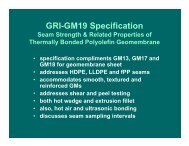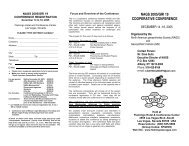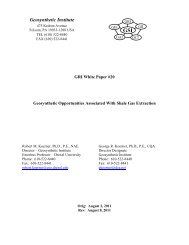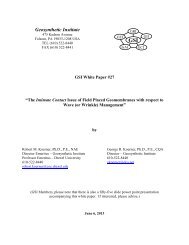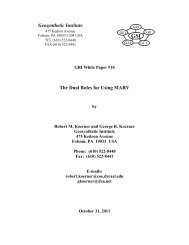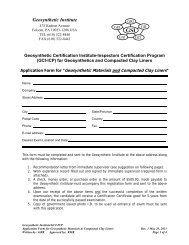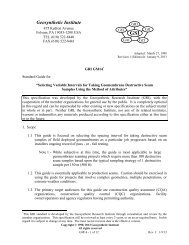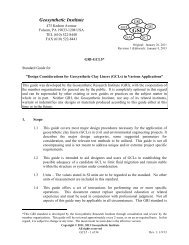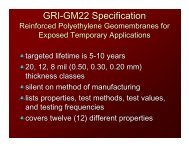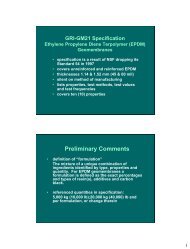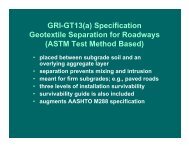December, 2012 - The Geosynthetic Institute
December, 2012 - The Geosynthetic Institute
December, 2012 - The Geosynthetic Institute
You also want an ePaper? Increase the reach of your titles
YUMPU automatically turns print PDFs into web optimized ePapers that Google loves.
Term Ends 2014<br />
Mark Sieracke - Weaver Boos (Consultants and<br />
Testing Labs)<br />
e-mail: msieracke@weaverboos.com<br />
Tim Rafter - CETCO (Geomembranes and GCLs)<br />
email: tim.rafter@cetco.com<br />
Wayne Hsieh - NPUST and GSI-Taiwan<br />
(International-2)<br />
e-mail: cwh@mail.npust.edu.tw<br />
Term Ends 2015<br />
John Workman - Waste Management Inc.<br />
(Owners and Operators)<br />
e-mail: jworkman@wm.com<br />
Mark Wayne – Tensar Earth Technology<br />
(Geotextiles and Geogrids)<br />
e-mail: mwayne@tensarcorp.com<br />
Presently being balloted (At-Large)<br />
Overview of GRI Projects<br />
(Research)<br />
Each issue of our Newsletter/Report provides a brief<br />
glimpse and update of current GRI research projects.<br />
It will be noted that most projects are of a very long<br />
duration; one being up to 50-years! (In this regard<br />
short projects are given to design firms or testing<br />
laboratories that are GSI Members). Details and full<br />
briefings are available to member organizations at their<br />
request. Dr. Grace Hsuan, Associate Director of GRI<br />
can be contacted for additional information as can the<br />
other project managers listed in the following write-ups.<br />
Projects marked with an asterisk have been written<br />
up as either short “in-progress” papers or<br />
complete papers. Grace can be reached by email<br />
or phone at (610)<br />
522-8440.<br />
Important Notice: Use of GSI/GRI generated data<br />
and information is for member organization use<br />
assuming that the information is not taken out of the<br />
context of which it was developed. When used for<br />
formal publications such as proposals, regulatory<br />
permits, brochures and advertisements we would<br />
appreciate seeing a draft copy for possible comments.<br />
Thank you for your cooperation in this regard.<br />
1. In-Situ Temperature Monitoring of Liner and<br />
Cover Geomembranes in Dry and Wet<br />
Landfills* - George Koerner is measuring the insitu<br />
temperature behavior of liner and cover<br />
geomembranes and has installed 60±<br />
thermocouples for long term measurements in<br />
both wet and dry municipal solid waste landfills<br />
in Pennsylvania. <strong>The</strong> project has been extended<br />
into its 15 th -year and has resulted in an<br />
extremely authoritative set of real-life data.<br />
2. Bioreactor (aka, Wet) Landfill Behavior and<br />
Properties* - One of the landfill cells mentioned<br />
in Item #1 is at field capacity, hence it is a true<br />
anaerobic bioreactor. Dr. George Koerner is in<br />
charge of considerable monitoring at this cell<br />
which includes the following<br />
waste moisture content<br />
waste temperature<br />
leachate chemical analysis<br />
waste gas analysis<br />
perched leachate within the waste<br />
Data is being collected on a quarterly basis. <strong>The</strong><br />
timeline of the project calls for monitoring up to<br />
10 years. This activity has been extended to an<br />
adjacent landfill to see how reproducible the data<br />
is with a slightly different waste mass.<br />
3. Flow Behavior of Fully Degraded Waste* - A<br />
field project under sponsorship of GSI and<br />
Waste Management investigates the drainage of<br />
highly degraded MSW placed directly on<br />
leachate collection systems. <strong>The</strong> leachate<br />
collection materials consist of both natural soils<br />
and geosynthetic drains. <strong>The</strong> experimental<br />
setup has been dismantled and a presentation<br />
was given at the <strong>2012</strong> Global Waste Conference<br />
in Phoenix… a paper will follow.<br />
4. Field Exposed Lifetime of Geogrids Used at<br />
the Facing of Landfill Berms - <strong>The</strong> facing of<br />
mechanically stabilized earth landfill berms (and<br />
other walls and slopes as well) is often using a<br />
wrap-around configuration leaving the geogrid<br />
exposed to the atmosphere. A new project<br />
being conducted by George Koerner for Waste<br />
Management is presently investigating two<br />
different geogrid’s behavior over time. A 50-year<br />
time frame is envisioned. <strong>The</strong> long-term behavior<br />
will eventually be compared to UV laboratory<br />
exposed data as noted in Item #7 below.<br />
5. Field Behavior of fPP and fPP-R<br />
Geomembranes - We continue to receive and<br />
evaluate field samples of flexible polypropylene<br />
geomembranes (mainly scrim reinforced). <strong>The</strong>y<br />
are regularly added to our database in this<br />
regard. <strong>The</strong> most recent was for potable water<br />
storage and had a service lifetime of 10-years.<br />
Using our correlation factor of 1200 light hours in<br />
D7238 at 70°C being equivalent to one-year in a<br />
hot climate, this is equivalent to a laboratory<br />
exposure in the weathering device of 12,000<br />
light hours. Our GRI-GM18 specification calls<br />
for 20,000 light hours for an acceptable<br />
formulation which is essentially a factor-of-safety<br />
of 1.7.<br />
6. Laboratory Exposed Lifetime of<br />
Geomembranes* - GSI is using three UVfluorescent<br />
devices to estimate the projected<br />
exposed lifetime of many different types of<br />
geomembranes. Presently being incubated are<br />
HDPE, LLDPE, fPP, PVC (N.A.), and EPDM.<br />
Exposure times of 50,000 light hours are now<br />
- 2 -



